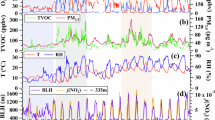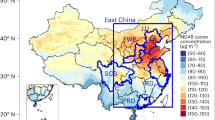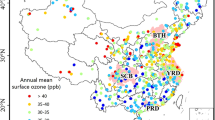Abstract
I REPORT here a preliminary investigation into the variation and destruction of ozone in the atmospheric surface layer. The measured destruction rates of ozone at the Earth's surface are in substantial agreement with those observed by Regener1. These observed destruction rates are considerably larger than those estimates of average destruction rates obtained from total ozone considerations and summarized by Junge2. The observed destruction rates, however, lie in a suitable range to give a satisfactory model when used in the global ozone budget formulated by Junge2.
This is a preview of subscription content, access via your institution
Access options
Subscribe to this journal
Receive 51 print issues and online access
$199.00 per year
only $3.90 per issue
Buy this article
- Purchase on SpringerLink
- Instant access to full article PDF
Prices may be subject to local taxes which are calculated during checkout
Similar content being viewed by others
References
Regener, V. H., J. Geophys. Res., 62, 221 (1957).
Junge, C. E., Tellus, 14, 363 (1962).
Author information
Authors and Affiliations
Rights and permissions
About this article
Cite this article
GALBALLY, I. Some Measurements of Ozone Variation and Destruction in the Atmospheric Surface Layer. Nature 218, 456–457 (1968). https://doi.org/10.1038/218456a0
Received:
Published:
Issue date:
DOI: https://doi.org/10.1038/218456a0
This article is cited by
-
Surface ozone variation associated with rainfall
Pure and Applied Geophysics PAGEOPH (1989)
-
Late evening ozone maxima
Pure and Applied Geophysics PAGEOPH (1981)
-
A theoretical investigation of tropospheric ozone and stratospheric-tropospheric exchange processes
Pure and Applied Geophysics (1973)
-
Short-term ground ozone fluctuations at Poona
Pure and Applied Geophysics (1973)
-
Ozone concentration studies and ozone flux measurements near the ground at Poona
Pure and Applied Geophysics (1973)



